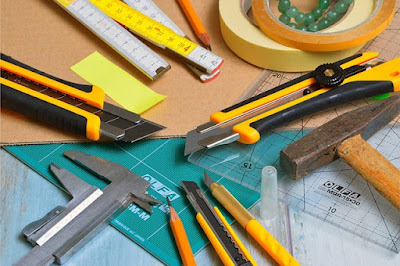Master Woodworking Basics: Guide to Stunning Projects
The Importance of Measuring and Marking Accurately
Before making a single cut, it’s critical to measure and mark your wood accurately. This seemingly small step is key to ensuring that your pieces fit together perfectly. A good rule in woodworking is to measure twice, cut once—a habit that saves time and avoids costly mistakes.
Key Tools for Measuring and Marking:
- Tape Measure: Essential for any woodworking project to measure lengths.
- Combination Square: Helps mark 90-degree and 45-degree angles for precise cuts.
- Marking Gauge: Ensures even lines when cutting joints.
Make sure to have these tools on hand for precise woodworking. Here’s a great resource for affordable woodworking tools to get you started.
%20(1).jpeg) | |
|
Mastering the Cut: Basic Sawing Techniques
Cutting wood is an essential skill in woodworking, and while power tools like circular saws and jigsaws make the job easier, knowing how to cut accurately with hand tools is crucial for precision work. Here are some basic sawing techniques every beginner should know:
- Crosscutting: Cutting across the grain of the wood, ideal for creating shorter pieces.
- Ripping: Cutting along the grain, used for creating longer strips of wood.
- Miter Cuts: Angled cuts, typically at 45 degrees, used for creating joints in frames or moldings.
If you’re looking for a great way to start cutting precisely, consider downloading these free woodworking plans, which offer easy-to-follow instructions on various projects.
Joining Wood: A Guide to Basic Wood Joints
One of the most critical parts of woodworking is learning how to join pieces of wood securely. There are several types of joints, each with its own purpose depending on the project:
- Butt Joint: The simplest joint where two pieces of wood are butted together and glued or nailed.
- Dado Joint: A slot cut into one piece of wood that holds another, commonly used for shelves.
- Mortise and Tenon: A strong joint where a projecting tenon fits into a corresponding mortise hole.
Using the right joint can make all the difference in the strength and appearance of your project. If you need help selecting tools for making these joints, check out this essential tools guide.
Sanding: The Key to a Smooth Finish
Sanding may seem tedious, but it’s the key to achieving a smooth, professional-looking finish. The process removes rough edges, evens out surfaces, and prepares the wood for staining or painting. Here’s how to approach sanding:
- Start with Coarse Grit: Use 60-80 grit sandpaper to remove rough surfaces or previous finishes.
- Move to Medium Grit: Use 120-150 grit sandpaper to smooth out imperfections.
- Finish with Fine Grit: Use 220-320 grit sandpaper for the final smoothing before applying stain or paint.
For those looking to speed up the sanding process, investing in a quality sander is key. You can find some of the best options in this woodworking tool guide.
Finishing Your Projects: Staining and Sealing
Once your piece is sanded, it’s time to finish it with stain or sealant. This step not only adds beauty to your project but also protects the wood from moisture and wear.
- Staining: Brings out the natural grain and color of the wood. Apply the stain evenly with a brush or cloth, and wipe off the excess for a uniform finish.
- Sealing: Protects the wood by creating a durable surface. Polyurethane, shellac, and lacquer are popular choices. Apply multiple thin coats, sanding between layers for the best results.
Looking for beginner-friendly woodworking plans that guide you through the finishing process? Download these free plans for step-by-step guidance.
FAQs
1. What are the basic woodworking techniques every beginner should learn?
Beginners should focus on essential techniques like accurate measuring and marking, basic cuts (crosscutting, ripping, miter cuts), wood joints (butt joint, dado joint), sanding, and finishing techniques.
2. What tools do I need to master basic woodworking techniques?
Basic tools include a tape measure, combination square, saws (circular, jigsaw, or hand saw), clamps, sandpaper, and finishing supplies like stain and polyurethane. For affordable tools, check out this tool guide.
3. How do I properly sand wood for a smooth finish?
Start with coarse grit sandpaper (60-80), then move to medium grit (120-150), and finish with fine grit (220-320). This process ensures a smooth surface ready for staining or painting.
4. What’s the best way to finish a woodworking project?
The best finish depends on the project. Staining enhances the natural grain, while sealants like polyurethane or lacquer protect the wood. Apply multiple thin coats for durability.
5. How do I make strong wood joints?
Strong joints depend on the type of project. Butt joints are simple but less strong, while mortise and tenon or dado joints offer greater stability and are commonly used in furniture making.
6. Where can I find beginner woodworking plans?
You can find free, beginner-friendly woodworking plans that guide you step-by-step through various projects here.
Conclusion
Mastering basic woodworking techniques is the foundation of every successful project. From accurate measuring and precise cuts to smooth sanding and finishing, these skills will set you up for success in any DIY project. Whether you’re just getting started or want to improve your craftsmanship, investing in quality tools and following detailed plans will help you craft beautiful, functional pieces.
If you’re ready to put these techniques into practice, don’t forget to explore these free woodworking plans for easy-to-follow project guides.
Related Articles:
Related Articles:






.jpeg)

.jpeg)
